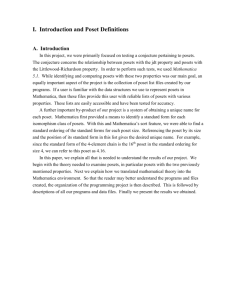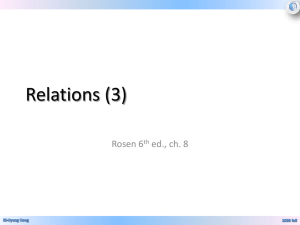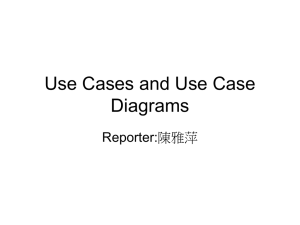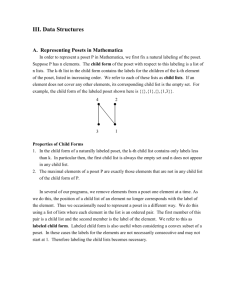lecture4.5
advertisement
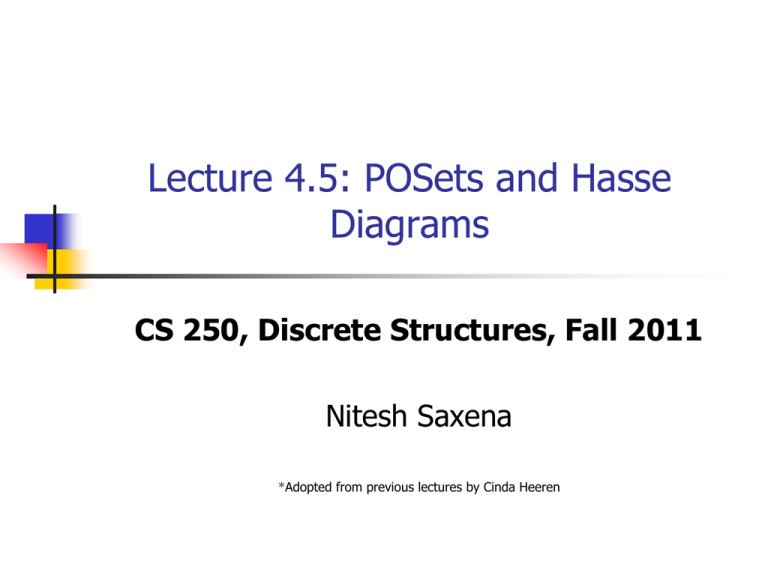
Lecture 4.5: POSets and Hasse
Diagrams
CS 250, Discrete Structures, Fall 2011
Nitesh Saxena
*Adopted from previous lectures by Cinda Heeren
Course Admin
HW4 has been posted
Covers the chapter on Relations (lecture 4.*)
Due at 11am on Nov 16 (Wednesday)
Also has a 10-pointer bonus problem
Please start early
Lecture 4.5 -- POSets and Hasse
Diagrams
Final Exam
Thursday, December 8, 10:45am1:15pm, lecture room
Heads up!
Please mark the date/time/place
Our last lecture will be on December 6
We plan to do a final exam review then
Lecture 4.5 -- POSets and Hasse
Diagrams
Outline
Hasse Diagrams
Some Definitions and Examples
Maximal and miminal elements
Greatest and least elements
Upper bound and lower bound
Least upper bound and greatest lower bound
Lecture 4.5 -- POSets and Hasse
Diagrams
Hasse Diagrams
Hasse diagrams are a special kind of graphs
used to describe posets.
Ex. In poset ({1,2,3,4}, ), we can draw the following picture
to describe the relation.
4
3
2
1
b
1.
Draw edge (a,b) if a
2.
Don’t draw up arrows
3.
Don’t draw self loops
4.
Don’t draw transitive edges
Lecture 4.5 -- POSets and Hasse
Diagrams
Hasse Diagrams
Have you seen this one before? String comparison
poset from last lecture
111
110
101
011
100
010
001
000
Lecture 4.5 -- POSets and Hasse
Diagrams
Maximal and Minimal
Consider this poset:
Reds are maximal.
Blues are minimal.
Lecture 4.5 -- POSets and Hasse
Diagrams
Maximal and Minimal: Example
Q: For the poset ({2, 4, 5, 10, 12, 20, 25}, |),
what is/are the minimal and maximal?
A: minimal: 2 and 5
maximal: 12, 20, 25
Lecture 4.5 -- POSets and Hasse
Diagrams
Least Element and Greatest Element
Definition: In a poset S, an element z is a
minimum (or least) element if bS, zb.
Intuition: If a is
maxiMAL, then no
one beats a. If a
is maxiMUM, a
beats everything.
Write the defn
of maximum
(geatest)!
Did you get
it right?
Must minimum and maximum
exist?
A. Only if set is finite.
B. No.
C. Only if set is transitive.
D. Yes.
Lecture 4.5 -- POSets and Hasse
Diagrams
Maximal and Minimal: Example
Q: For the poset ({2, 4, 5, 10, 12, 20, 25}, |),
does the minimum and maximum exist?
A: minimum: [divisor of everything] No
maximum: [multiple of everything] No
Lecture 4.5 -- POSets and Hasse
Diagrams
A Property of minimum and maximum
Theorem: In every poset, if the maximum
element exists, it is unique. Similarly for
minimum.
Proof: Suppose there are two maximum
elements, a1 and a2, with a1a2.
Then a1 a2, and a2a1, by defn of
maximum.
So a1=a2, a contradiction.
Thus, our supposition was incorrect, and
the maximum element, if it exists, is
unique.
Similar proof for minimum.
Lecture 4.5 -- POSets and Hasse
Diagrams
Upper and Lower Bounds
Defn: Let (S, ) be a partial order. If AS, then
an upper bound for A is any element x S
(perhaps in A also) such that a A, a x.
A lower bound for A is any x S such that
a A, x a.
Ex. The upper bound of {g,j}
a
c
g
b
d
e
f
h
i
j
is a. Why not b?
Ex. The upper bounds of {g,i}
is/are…
A. I have no clue.
{a, b} has no
B. c and e
UB.
C. a
D. a, c, and e
Lecture 4.5 -- POSets and Hasse
Diagrams
Upper and Lower Bounds
Defn: Let (S, ) be a partial order. If AS, then
an upper bound for A is any element x S
(perhaps in A also) such that a A, a x.
A lower bound for A is any x S such that
a A, x a.
Ex. The lower bounds of {a,b}
a
c
g
b
d
e
f
h
i
j
are d, f, i, and j.
Ex. The lower bounds of {c,d}
is/are…
A. I have no clue.
B. f, i
{g, h, i, j}
C. j, i, g, h
has no LB.
D. e, f, j
Lecture 4.5 -- POSets and Hasse
Diagrams
Least Upper Bound and
Greatest Lower Bound
Defn: Given poset (S, ) and AS, x S is a least
upper bound (LUB) for A if x is an upper bound
and for upper bound y of A, x y.
x is a greatest lower bound (GLB) for A if x is a lower
bound and if y x for every lower bound y of A.
a
c
g
b
d
e
f
h
i
j
Ex. LUB of {i,j} = d.
Ex. GLB of {g,j} is…
A. I have no clue.
B. a
C. non-existent
D. e, f, j
Lecture 4.5 -- POSets and Hasse
Diagrams
LUB and GLB
Ex. In the following poset, c and d are lower
bounds for {a,b}, but there is no GLB.
Similarly, a and b are upper bounds for
{c,d}, but there is no LUB.
a
b
c
d
This is
because c and
d are
incomparable.
Lecture 4.5 -- POSets and Hasse
Diagrams
Another Example
What are the GLB and LUB, if they exist, of
the subset {3, 9, 12} for the poset (Z+, |)?
What are the GLB and LUB, if they exist, of
the subset {1, 2, 4, 5, 10} for the poset
(Z+, |)
Lecture 4.5 -- POSets and Hasse
Diagrams
Another Example
What are the GLB and LUB, if they exist, of
the subset {3, 9, 12} for the poset (Z+, |)?
LUB: [least common multiple] 36
GLB: [greatest common divisor] 3
What are the GLB and LUB, if they exist, of
the subset {1, 2, 4, 5, 10} for the poset
(Z+, |)
LUB: [least common multiple] 20
GLB: [greatest common divisor] 1
Lecture 4.5 -- POSets and Hasse
Diagrams
Example to sum things up
For the poset ({2, 4, 6, 9, 12, 18, 27, 36, 48,
60, 72}, |), find the following:
1.
2.
3.
4.
5.
6.
7.
8.
Maximal element(s)
Minimal element(s)
Greatest element, if it exists
Least element, if it exists
Upper bound(s) of {2, 9}
Least upper bound of {2, 9}, if it exists
Lowe bound(s) of {60, 72}
Greatest lower bound of {60, 72}, if it exists
Lecture 4.5 -- POSets and Hasse
Diagrams
Example to sum things up
For the poset ({2, 4, 6, 9, 12, 18, 27, 36, 48,
60, 72}, |), find the following:
1.
2.
3.
4.
5.
6.
7.
8.
Maximal element(s) [not divisors of anything]
27, 48, 60,
72
Minimal element(s) [not multiples of anything]
2, 9
Greatest element, if it exists [multiple of everything]No
Least element, if it exists [divisor of everything]
No
Upper bound(s) of {2, 9} [common multiples]
18, 36, 72
Least upper bound of {2, 9}, if it exists [least common
multiple] 18
Lower bound(s) of {60, 72} [common divisors]
2, 4, 6, 12
Greatest lower bound of {60, 72}, if it exists [greatest
common divisor] 12
Lecture 4.5 -- POSets and Hasse
Diagrams
More Theorems
Theorem: For every poset, if the LUB for a set
exist, it must be unique. Similarly for GLB.
Proof: Suppose there are two LUB elements, a1 and a2,
with a1a2.
Then a1 a2, and a2a1, by defn of LUB.
So a1=a2, a contradiction.
Thus, our supposition was incorrect, and the LUB, if it
exists, is unique.
Similar proof for GLB.
Lecture 4.5 -- POSets and Hasse
Diagrams
Today’s Reading
Rosen 9.6
Lecture 4.5 -- POSets and Hasse
Diagrams

